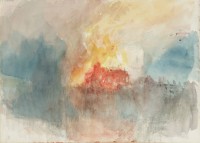 A series of nine watercolors by Joseph Mallord William Turner in the Tate Gallery, long thought to be studies for two oil paintings called The Burning of the Houses of Parliament or The Burning of the Houses of Lords and Commons, in fact depict a later fire at an entirely different landmark: the Tower of London. The original identification was made in 1909 by art historian and Turner biographer A.J. Finberg who helped catalogue some of the massive Turner Bequest. Not all experts were persuaded that Finberg’s identification was correct, but there didn’t seem to be a viable alternative hypothesis so the Parliament title stood.
A series of nine watercolors by Joseph Mallord William Turner in the Tate Gallery, long thought to be studies for two oil paintings called The Burning of the Houses of Parliament or The Burning of the Houses of Lords and Commons, in fact depict a later fire at an entirely different landmark: the Tower of London. The original identification was made in 1909 by art historian and Turner biographer A.J. Finberg who helped catalogue some of the massive Turner Bequest. Not all experts were persuaded that Finberg’s identification was correct, but there didn’t seem to be a viable alternative hypothesis so the Parliament title stood.
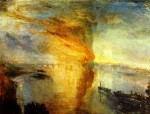 The fire at the old Houses of Parliament took place on October 16th, 1834. Fire broke out just before 7:00 PM and quickly devoured the Houses of Lords, Commons and all the adjacent buildings. Tens of thousands assembled to watch the flames and Turner was among them with his sketchbook. Later that year or early in 1835, he completed two
The fire at the old Houses of Parliament took place on October 16th, 1834. Fire broke out just before 7:00 PM and quickly devoured the Houses of Lords, Commons and all the adjacent buildings. Tens of thousands assembled to watch the flames and Turner was among them with his sketchbook. Later that year or early in 1835, he completed two 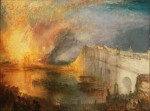 different versions of the subject based off the quick sketches he drew from the south bank of the Thames. Those oil paintings are now in the Cleveland Museum of Art and the Philadelphia Museum of Art
different versions of the subject based off the quick sketches he drew from the south bank of the Thames. Those oil paintings are now in the Cleveland Museum of Art and the Philadelphia Museum of Art
The watercolors are painted in broad, nearly abstract strokes of color making the shape of the buildings hard to distinguish. It was Matthew Imms, Tuner Curator at the Tate working on a new comprehensive catalog of the Bequest, who researched new possible candidates for the conflagration. His starting point was the dating. That abstract style is indicative of Turner’s later work, so Imms dug through periodicals of the late 1830s and Turner’s papers looking for any other major city fire the artist may have witnessed. That’s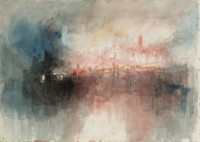 when he came across prints and descriptions of the Tower of London fire of 1841 and found architectural features that matched certain elements of the watercolors.
when he came across prints and descriptions of the Tower of London fire of 1841 and found architectural features that matched certain elements of the watercolors.
“The building that burned was called The Grand Storehouse, in the late 17th-century English Baroque style—red brick with stone dressings—and it held the historic armoury collections of cannons, and all the guns and rifles and so on that had been used in previous campaigns. Whether there was anything flammable among those, I’m not sure,” Imms says, “but they kept tents in the roof, so that would be good kindling.”
“The cupola and long, tall windows of the ill-fated building are the dominant architectural details in the watercolours, but more familiar buildings also stand out. There’s a classical pediment in one of the watercolours, with what seems to be the White Tower in the background,” he says. “It’s one of the ones that people thought was Westminster Abbey, but the turrets are too small and far apart, so we think it’s the White Tower.”
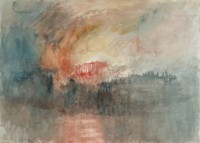 Although no direct references to witnessing the fire have yet been found in his papers, there is correspondence that proves he asked for permission to visit the grounds right after the fire. On November 3rd, 1841, just four days after the fire broke out the night of October 30th, Turner received a letter from the Field Marshal Arthur Wellesley, Duke of Wellington, hero of Waterloo and commandant of the Tower, refusing him access. Nobody was to be admitted unless they had legitimate business there.
Although no direct references to witnessing the fire have yet been found in his papers, there is correspondence that proves he asked for permission to visit the grounds right after the fire. On November 3rd, 1841, just four days after the fire broke out the night of October 30th, Turner received a letter from the Field Marshal Arthur Wellesley, Duke of Wellington, hero of Waterloo and commandant of the Tower, refusing him access. Nobody was to be admitted unless they had legitimate business there.
Some of the series of nine watercolors will go on display at the Tate starting on September 10th. They will be part of The EY Exhibition: Late Turner – Painting Set Free, a show dedicated to Turner’s glowing later works. They will be redated based on the new research. No word yet on whether they’ll be renamed.
Is it fair to say that he must have been a ‘frantic pyromantic’ ?